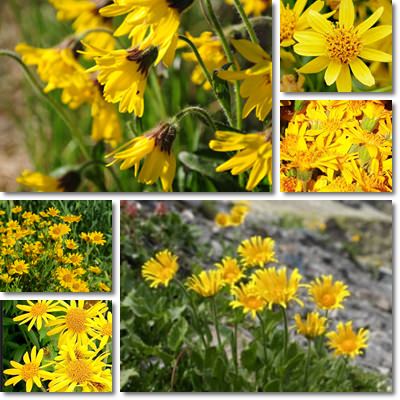A medicinal herb occurring naturally across Europe, arnica (Arnica montana) is a beautiful, yellow wild flowering plant that can be found up to 3.000 m in altitude. Arnica is presently at risk of becoming extinct as a result of agricultural expansion invading its natural habitat and polluting it. The herb grows in poor, acidic soil types and is collected for medicinal purposes alone. The part used is the flower head as it contains powerful chemical constituents with beneficial effects on our health.
Arnica is predominantly used for its excellent anti-inflammatory properties in the form of a topical gel to relieve muscle and joint pain caused by arthritis, rheumatoid arthritis, injuries and trauma, swelling associated with broken limbs, sprains and aches as a result of intense physical exercise and so on. It can also be used internally in the form of herbal infusions to help relieve inflammation and pain.

What does arnica look like?
Arnica is a wild flower which grows up to 60-70 cm in height. It has hairy green stems and produces bright yellow flowers starting from May and up until August. Arnica flowers look like miniature sunflowers with yellow discs in the middle, surrounded by slender-looking, elongated bright yellow petals. The sepals form a sort of green cup at the base of the flower where they hold the tips of the petals. From certain angles, arnica flowers look a bit like dandelions.
The purported health benefits of the arnica plant are a result of the chemical composition of the flower heads. Basically, what makes arnica healthy is a combination of naturally-occurring constituents such as volatile essential oils, thymol, sesquiterpene lactones such as helenalin and flavanone glycosides from the flavonoid family. Some compounds act as anti-inflammatory and anticancer agents, while some engender both a positive reaction and side effects such as allergic reactions or toxicity.
What is arnica good for?
Arnica is used for a variety of medical conditions, generally to improve or relieve pain, reduce swelling, act as a local antimicrobial to prevent infections, etc. It is important to note that arnica belongs to the sunflower family Asteraceae and may engender allergic reactions as a result of its sesquiterpene lactones and polyacetylenes content. Members of the sunflower family including sunflowers, daisies, marigold (calendula), Echinacea (purple coneflower), yarrow, dandelion and others are very likely to produce allergic reactions, often more severe than other medicinal plants.
Also see the benefits of yarrow.

What are the benefits of arnica?
As far as health benefits are concerned, here is a list of conditions and ailments arnica may help with:
- Arthritis pain and swelling in the joints (especially good for osteoarthritis of the knees and hands).
- Pain and inflammation caused by ligament sprains.
- Muscle aches caused by intense physical exercise or lifting heavy weights.
- Swelling associated with broken bones.
- Muscle inflammation and pain as a result of injury and trauma.
- Bruising as a result of tissue trauma.
- Venitis or phlebitis (inflammation of the superficial leg veins) pain, swelling and burning sensation.
- Mouth ulcers and insect bites, burns.
- Some of the top uses of arnica include: local antibacterial, anti-inflammatory and wound healing agent, often times prescribed following surgery (in medical-grade preparations).
- Skin disorders such as acne, but should not be applied on open wounds.
Research findings: what do studies say about arnica?
According to existing research, arnica owes its health benefits to its chemical constituents, bioavailable compounds found naturally in the flower heads of the species. More and more studies confirm the effectiveness of arnica-based gels and topical ointments in the treatment of osteoarthritis swelling and pain, especially in the hands and knees (Arnica montana gel in osteoarthritis of the knee: an open, multicenter clinical trial, 2002 and Homeopathic arnica therapy in patients receiving knee surgery: Results of three randomised double-blind trials, 2006).
Moreover, some studies suggest that gel preparations from arnica may be as efficient as non-steroidal anti-inflammatory medication such as ibuprofen, but with less side effects when used as prescribed (Choosing between NSAID and arnica for topical treatment of hand osteoarthritis in a randomised, double-blind study). Topical preparations can successfully relieve muscle swelling causing pain and discomfort as well as inflammation related to sprains.
Arnica has been shown to efficiently and rapidly help treat skin conditions such as deep bruising as a result of injury and trauma, bruising following surgery, even acne and superficial leg vein inflammation or other skin conditions requiring pain relief and swelling reduction (Effect of homeopathic Arnica montana on bruising in face-lifts: results of a randomized, double-blind, placebo-controlled clinical trial).
Numerous surgeons prescribe it to their patients for its antimicrobial, anti-inflammatory and pain-relieving properties. Arnica before surgery is believed to reduce blood clot risks. Nevertheless, in both cases, the use of the plant should be regulated and directly supervised by a medical professional. Helenalin, the same irritating compound in arnica, also exhibits antitumor properties and may exert toxic effects on cancer cells as well.
The higher the concentration of Arnica montana in a topical gel, tincture, extract, etc., the more pronounced its health benefits. Nevertheless, do not eat arnica flowers. If consumed in large amounts, the plant can have toxic effects due to its helenalin content. Helenalin is a type of sesquiterpene lactone and may cause skin irritation, eczema or peeling when applied topically, especially on open wounds.
If ingestion of large doses of pure arnica occurs, it can trigger severe gastrointestinal problems such as vomiting, internal bleeding, shortness of breath, dizziness, vision loss, kidney damage, liver damage even coma. Overdose with homeopathic arnica products can have the same side effects, despite the products containing extremely low amounts of the plant.
Arnica is not recommended during pregnancy and following birth. The plant is believed to increase miscarriage risks and pass into the mother’s milk, posing serious health risks for newborns. Moreover, the herb may potentiate the effects of anticoagulants and, as a result, anyone under anticoagulant medication should talk to a medical professional before taking any form of the plant.
Conclusion
Overall, available preparations of the Arnica montana plant are safe and exhibits quite potent anti-inflammatory, pain-relieving and antibacterial activity. Oral preparations or pure extracts, however, may pose serious health risks when recommended doses are exceeded. Swollen leg veins, deep bruises, osteoarthritis joint pain and general muscle pain can be relieved with the help of arnica preparations.
